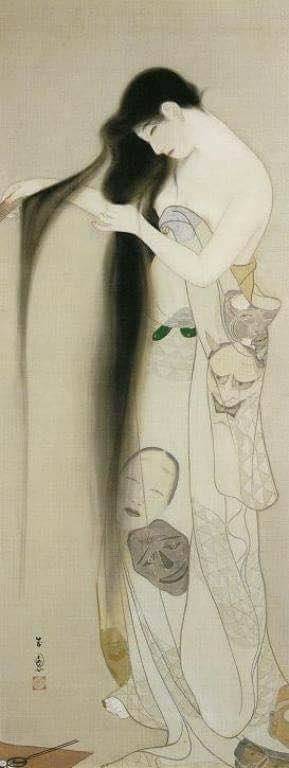#Oide Toko
Photo

Oide Toko, Cat Watching a Spider, 1888-92, Ink and color on silk, 14 3/4" x 11"
2K notes
·
View notes
Text
Encore (アンコール) - UraShimaSakataSen (浦島坂田船) Color Coded Lyrics
Please note that the color coding is done like this;
Uratanuki Shima Sakata Senra
❤️❤️ Duo (heart colours depending on who is doing said part)
All
Disclaimer: I am not fluent in Japanese, therefore all romaji are done based on what I found in online dictionaries/google translate and edited by me.
youtube
Lyrics and composition: DECO*27
Arrangement: TeddyLoid
Japanese
こっちおいで いけるとこまで発火
こすって グリスを塗って
悪化しちゃった 目が回る罠 発作
キマって 夢中になって
Night (ah ah, ah ah)
Night (ah ah, ah ah)
何回したって 足んないんだって アンコールちょうだい
限界なんて 関係ないじゃん 狂っていこう
厭厭を聴かせてくれ (Take on me)
喘いでビートに乗せて (Take on me)
不協和音からのハーモニー (Take on me)
普通には戻れない 妄想が止まらない
Yeah Yeah Yeah
Yeah Yeah Yeah
Yeah Yeah Yeah
終わらないアンコール
Yeah Yeah Yeah
Yeah Yeah Yeah
Yeah Yeah Yeah
終わらないアンコール
こっちおいで 重ねるたびに 落下
染まって 無言のOK
「もっと」だって 君次第だよ やっぱ
メロって エラー起こしてんじゃん
もうどうしようもない ねえどうしようもないほど
💜💚 声を上げちゃう君が見たい
もうどうしようもない ねえどうしようもないほど
❤️💛 壊れていく君を知りたい
痛いくらい締め付けてくれ (Take on me)
歪んだ笑顔を添えて (Take on me)
理想に壊されるまで (Take on me)
残響が鳴り止まない リピートに溺れたい
Night (ah ah, ah ah)
Night (ah ah, ah ah)
Night (ah ah, ah ah)
Night (ah ah, ah ah)
「何回目?」って 「もういいね」って 💜💛 冗談、りょーかい
ホントはだって こんなんなって ❤️💚 悪い子じゃん
厭厭を聴かせてくれ (Take on me)喘いでビートに乗せて (Take on me)不協和音からのハーモニー (Take on me)
普通には戻れない 妄想が止まらない
Yeah Yeah Yeah
Yeah Yeah Yeah
Yeah Yeah Yeah
終わらないアンコール
Yeah Yeah Yeah
Yeah Yeah Yeah
Yeah Yeah Yeah
終わらないアンコール
Romaji
Kotchi oide ikeru toko made hakka
Kosutte gurisu o nutte
Akka shi chatta megamawaru wana hossa
Kima tte muchū ni natte
Night (ah ah, ah ah)
Night (ah ah, ah ah)
Nankai shitatte tannai n datte ankōru chōdai
Genkai nante kankeinaijan kurutte ikou
Iyaiya o kika sete kure (Take on me)
Aeide bīto ni nosete (Take on me)
Fukyōwaon kara no hāmonī (Take on me)
Futsū ni wa modorenai mōsō ga tomaranai
Yeah Yeah Yeah
Yeah Yeah Yeah
Yeah Yeah Yeah
Owaranai ankōru
Yeah Yeah Yeah
Yeah Yeah Yeah
Yeah Yeah Yeah
Owaranai ankōru
Kotchi oi de kasaneru tabi ni rakka
Somatte mugon no OK
`Motto' datte kimi shidaida yo yappa
Mero tte erā okoshi tenjan
Mō dō shiyō mo nai nee dō shiyō mo nai hodo
💚💜 Koe o age chau kimi ga mitai
Mō dō shiyō mo nai nee dō shiyō mo nai hodo
❤️💛 Kowarete iku kimi o shiritai
Itai kurai shimetsukete kure (Take on me)
Yuganda egao o soete (Take on me)
Risō ni kowasa reru made (Take on me)
Zankyō ga nari yamanai ripīto ni oboretai
Night (ah ah, ah ah)
Night (ah ah, ah ah)
Night (ah ah, ah ah)
Night (ah ah, ah ah)
Nankaime?' Tte mō ī ne' tte 💜💛 jōdan ryōkai
Honto wa datte konnan natte ❤️💚 warui kojan
Iyaiya o kika sete kure (Take on me)Aeide bīto ni nosete (Take on me)
Fukyōwaon kara no hāmonī (Take on me)
Futsū ni wa modorenai mōsō ga tomaranai
Yeah Yeah Yeah
Yeah Yeah Yeah
Yeah Yeah Yeah
Owaranai ankōru
Yeah Yeah Yeah
Yeah Yeah Yeah
Yeah Yeah Yeah
Owaranai ankōru
#USSS#urashimasakatasen#uratanuki#shima#aho no sakata#senra#utaite#USSS original song#color coded lyrics#ccl#Youtube
0 notes
Photo
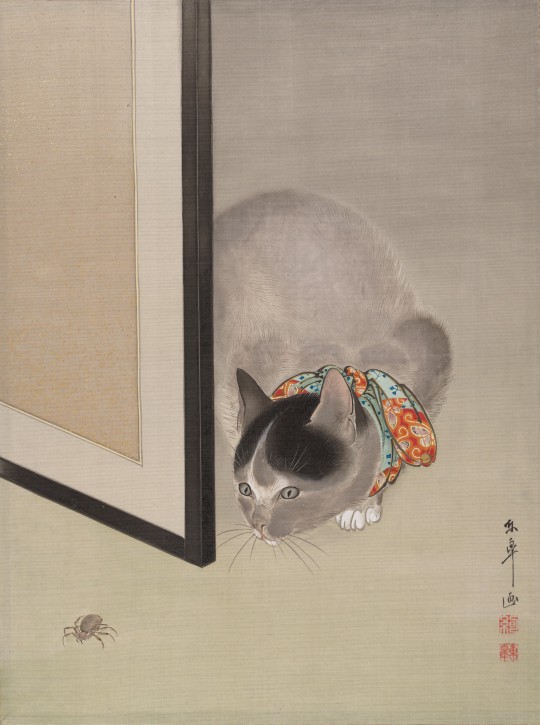
Cat Watching a Spider, Oide Tōkō, circa 1888-92
Ink and color on silk album leaf
14 ¾ x 11 in. (37.5 x 27.9 cm)
The Metropolitan Museum of Art, New York City, NY, USA
#art#painting#oide toko#asian art#east asian art#1880s#1890s#ink and color#album leaf#cats#animals#spiders#the met#japanese#100 notes
192 notes
·
View notes
Photo
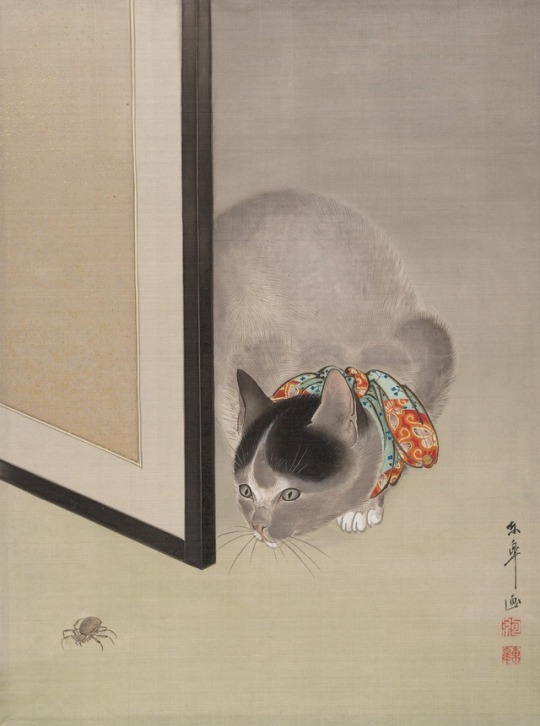
Cat Watching a Spider, 1888-92 by Ōide Tōkō (Japanese, 1841--1905)
1K notes
·
View notes
Photo

Da-iCE LYRICS: Love Song | CGM
With implied and literal translation. Based on my current Japanese level and research. This might change and be updated. PM me for mistakes/errors. Please put proper credits if you use.
Love Song
ENGLISH TRANSLATION + KANJI + ROMAJI
From: SiX (2021)
Composer: Takahito Uchisawa (内澤崇仁)
Lyricist: Takahito Uchisawa (内澤崇仁)
You resemble the snow that falls softly
そっと降る雪が君に似てるな
Sotto furu yuki ga kimi ni niteru na
~
Hey, I want to meet you
ねえ 会いたいよ
Nee aitai yo
~
I feel too lonely
寂しすぎるよ
Sabishi sugiru yo
~
If I close my eyes, you become near me
目を閉じれば近くにいるの
Me o tojireba chikaku ni iru no
~
You are beautiful when you smile
笑う君は美しい
Warau kimi wa utsukushii
~~~~~~
You draw a little shy look
君は少し照れた顔して
Kimi wa sukoshi tereta kao shite
~
You lift your scarf up to the tip of your nose
鼻先までマフラーをあげるの
Hanasaki made MAFURAA o ageru no
~
Aa, I found you
ああ 僕は君を見つけたんだ
Aa boku wa kimi o mitsuketanda
~
I’m the happiest in the world
世界一幸せ
Sekaiichi shiawase
~~~~~~
As though you are
まるで君はさ
Marude kimi wa sa
~
A princess who’s all alone
一人きりのプリンセス
Hitorikiri no PURINSESU
~
I’ll be your knight
僕はナイト
Boku wa NAITO
~
Don’t be sad
悲しまないで
Kanashimanai de
~
I’ll rescue you, honey
助けに来たよハニー
Tasuke ni kita yo HANII
~~~~~~
The world is filled with love songs
世界中がラブソングで溢れる
Sekaijuu ga RABU SONGU de afureru
~
Come to me, I’ll warm you up
おいでよ あたためてあげる
Oide yo atatamete ageru
~
Your Love Song
-君のLove Song-
Kimi no Love Song
~~~~~~
If it can’t be helped, go and use
しょうがないな どうぞ使って
Shouganai na douzo tsukatte
~
My hands as your gloves
手袋は僕の手
Tebukuro wa boku no te
~
These arms as your scarf
この腕はマフラー
Kono ude wa MAFURAA
~
My embrace as your coat
抱きついてコートにして
Dakitsuite KOOTO ni shite
~
The more I think of you, the more I feel my heart becoming a song
君を思えば思うほど心がまた歌になる
Kimi o omoeba omou hodo kokoro ga mata uta ni naru
~
I have this comforting reason because of you
あったかい理由は君のせい
Attakai riyuu wa kimi no sei
~~~~~~
Every time we can’t meet is
会えない時間は
Aenai jikan wa
~
A seasoning that will make us love even more
もっと好きになる調味料
Motto suki ni naru choumiryou
~
Let’s taste it together
味わっておこうよ
Ajiwatte okou yo
~
I want to love you, honey
愛したいんだよハニー
Aishitainda yo HANII
~~~~~~
The world is a stage of love songs
世界中がラブソングのステージ
Sekaijuu ga RABU SONGU no SUTEEJI
~
I’ll take you anywhere
どこでも連れてってあげる
Doko demo tsuretette ageru
~
Let it be the box seat, next to you
特等席だよ 君の隣は
Tokutou seki da yo kimi no tonari wa
~~~~~~
Again, I’ll get to know you like the first time
また初めての君を知ってしまった
Mata hajimete no kimi o shitte shimatta
~
I like those times
そういうとこが好き
Sou iu toko ga suki
~
Even if you change a lot as we move forward
君がこれからいくつも変わっていっても
Kimi ga kore kara ikutsu mo kawatteitte mo
~
I’ll fall in love with every change
変わるたび恋をする
Kawaru tabi koi o suru
~
Even if we separate someday
もしいつか離れても
Moshi itsuka hanarete mo
~
Even if one of us departs
どっちかがいなくなったとしても
Docchi ka ga inaku natta to shite mo
~
If you’re crying, I’ll come right away
泣いてるならすぐに行く
Naiteru nara sugu ni iku
~
If you’re lonely, I’ll hold your hand
寂しいなら手を握る
Sabishii nara te o nigiru
~
I’ll stroke your hair, make you laugh, and embrace you
髪を撫でる 笑わせる 抱きしめる
Kami o naderu warawaseru dakishimeru
~
Forever
ずっと
Zutto
~~~~~~
My heart will become your love song
ココロがラブソングになって
Kokoro ga RABU SONGU ni natte
~
Your starting point and destination
君の元へと向かう
Kimi no moto e to mukau
~
Will it be a give and take?
受け取ってくれるかい?
Uketotte kureru kai?
~~~~~~
The world is filled with love songs
世界中がラブソングで溢れる
Sekaijuu ga RABU SONGU de afureru
~
Come to me, I’ll warm you up
おいでよ あたためてあげる
Oide yo atatamete ageru
~
I will give, over and over, love songs for you
何度も贈るよ 君へのラブソングを
Nandomo okuru yo kimi e no RABU SONGU o
~
A song that swears my love
愛を誓う歌
Ai o chikau uta
~
Your Love Song
-君のLove Song-
Kimi no Love Song
21 notes
·
View notes
Text
ain’t nobody STOP - Lyrics and translation
ain’t nobody STOP by REIJINGSIGNAL
Romaji
Make Some Noise!!
Countdown!!
Stupid!!
kick-ass!!
Genkaichi girigiri made Get it Get it
tsureteku Zone
Pump it up!!
Hey man!!
Crazy!!
Break out!!
Amaku minaide?
Tomaranai Clash
mesamase Guys
uneru jidai Change
sashikomu wa Chance
tsukinai Emotion
sonosaki e
itte mitai desho
dattara oide
shigeki-tekina Show
miseteageru
Oh Rise okizari ni suru kurai
muchūna no ga chōdo ii
shōri shika shiranai
Hate atsume chau hodo kageki
butchigiri no pafōmansu
meshiagare
reberu tarinai n janai? (Loud! Loud!)
Mada agarudesho? (Loud! Loud!)
Sonna nja kokoro ugokanai wa
shikō teishi no utage ni wa fu tsuriai
dare mo jama sa senai (No! No!)
Waki agaru gēji (No! No!)
Furikireru made issoko no mama
gaman nante dekiyashinai
tomaranai Clash
mesamase Guys
shibaru jōshiki
ori haratte Glow
zettai fukahi Pain
sore sae mo Ask
kimochiidesho
No Rave gotaku mo chūkoku mo
ainiku to uketsuke tenai
okashita risuku o
Bet zenrei de sasageru
oishī toko tori nante
yurusanai
yudan shi teru n janai? (Hey! Hey!)
Mō teokure yo? (Hey! Hey!)
Egoizumu no rinne ga shihai suru
kibō kansokusha no aite wa gomen
nani mo negawanai (No! No!)
Waki agaru imēji (No! No!)
Shōdō ni makasete ugokidasu
kinō nante mieyashinai
te nobase Now
(Noise! ! Noise! ! Noise! ! Noise Noise!)
Kawashita omoi ketsui yurugasu
kasenaraba kirisuteru
ganbō ijō katsubō miman nante
kireigoto tsūyō shinai Stage
odore
reberu tarinai n janai? (Loud! Loud!)
Mada agarudesho? (Loud! Loud!)
Sonna nja kokoro ugokanai wa
shikō teishi no utage ni wa fu tsuriai
dare mo jama sa senai (No! No!)
Waki agaru gēji (No! No!)
Furikireru made issoko no mama
gaman nante dekiyashinai
tomaranai Clash
mesamase Guys
~
English Translation
Make Some Noise!!
Countdown!!
Stupid!!
kick-ass!!
To the limit, Get it Get it
Take me to the Zone
Pump it up!!
Hey man!!
Crazy!!
Break out!!
Doesn't it look sweet?
Never ending Clash
Awaken now Guys
The swelling era Change
I'll plug in the Chance
Endless Emotion from here on
Come here if you want to see it
I'll let you see an exciting Show
Oh Rise to the point you're left behind
It's great to be engrossed in it
Victory is the only thing to know
Extreme till Hate manifests
This perfect performance
Here, enjoy it
The volume level ain't enough right? (Loud! Loud!)
It's still going up right? (Loud! Loud!)
That still doesn't move my heart
Stop thinking, it's disproportionate to this feast
No one shall get in our way (No! No!)
Spring up the gauge (No! No!)
Stay as you are until you shake it off
I just can't stand it anymore
Never ending Clash
Awaken now Guys
Common sense tied down and Glow
This absolute inevitable Pain
Even when Asked, it feels good
No Rave Both trust and advice
I won't accept them as hate
Take the risk,
Place a Bet with your all
Like it is delicious
Unforgivable
You weren't careful right? (Hey! Hey!)
It may be too late you know? (Hey! Hey!)
Egoism reincarnates and dominates
Sorry for just hoping as an observer
Don't wish for anything (No! No!)
Spring up an image (No! No!)
Leave it to your gut and start moving
And you won't be able to see yesterday
Reach your hand out
(Noise!! Noise!! Noise!! Noise Noise!)
Exchanged thoughts
Cut them off if they're cuffs that shakes your determination
More of a desire, less than a lust
On a Stage that doesn't work
Dance
The volume level ain't enough right? (Loud! Loud!)
It's still going up right? (Loud! Loud!)
That still doesn't move my heart
Stop thinking, it's disproportionate to this feast
No one shall get in our way (No! No!)
Spring up the gauge (No! No!)
Stay as you are until you shake it off
I just can't stand it anymore
Never ending Clash
Awaken now Guys
~
Kanji
Make Some Noise!!
Countdown!!
Stupid!!
kick-ass!!
限界値ギリギリまで Get it Get it
連れてくZone
Pump it up!!
Hey man!!
Crazy!!
Break out!!
甘く見ないで?
止まらないClash 目覚ませGuys
うねる時代Change 差し込むわChance
尽きないEmotion その先へ
行ってみたいでしょ だったらおいで
刺激的なShow 見せてあげる
Oh Rise 置き去りにするくらい
夢中なのがちょうど良い
勝利しか 知らない
Hate 集めちゃうほど過激
ぶっちぎりのパフォーマンス
召し上がれ
音量(レベル)足りないんじゃない?(Loud!Loud!)
まだ上がるでしょ?(Loud!Loud!)
そんなんじゃ心動かないわ 思考停止の宴には 不釣り合い
誰も邪魔させない(No!No!)
湧き上がるゲージ(No!No!)
振り切れるまでいっそこのまま
我慢なんて できやしない
止まらないClash 目覚ませGuys
縛る常識 降り払ってGlow
絶対不可避Pain
それさえも Ask 気持ち良いでしょ
No Rave 御託も忠告も
生憎と 受け付けてない
冒したリスクを
Bet 全霊で捧げる 美味しいとこ取りなんて
許さない
油断してるんじゃない?(Hey!Hey!)
もう手遅れよ?(Hey!Hey!)
エゴイズムの輪廻が支配する 希望観測者の相手はゴメン
何も願わない(No!No!)
湧き上がるイメージ(No!No!)
衝動に任せて動き出す
昨日なんて 見えやしない
手伸ばせ Now
(Noise!! Noise!! Noise!! Noise Noise!)
交わした思い 決意揺るがす枷ならば 切り捨てる
願望以上 渇望未満 なんて綺麗事
通用しないStage 踊れ
音量(レベル)足りないんじゃない?(Loud!Loud!)
まだ上がるでしょ?(Loud!Loud!)
そんなんじゃ心動かないわ 思考停止の宴には 不釣り合い
誰も邪魔させない(No!No!)
湧き上がるゲージ(No!No!)
振り切れるまでいっそこのまま
我慢なんて できやしない
止まらないClash 目覚ませGuys
2 notes
·
View notes
Text
Nampō Roku, Book 2 (13b): (1587) Twelfth Month, Sixteenth Day, After the Morning Meal, Part 2.

13b) After [chanoyu in the small room] was finished, [Hideyoshi] deigned to go out into the shoin; [and] Oshō took his leave¹.
▵ Shiru tsuru [汁 鶴]².
▵ Namasu [鱠]³.
▵ Ni-mono hara-hara kou imo [煮物 ハラ〰 コホウ イモ]⁴.
▵ Ni-no-shiru tara [二ノ汁 鱈]⁵.
▵ Kawarake ko-tori [カハラケ 小鳥]⁶.
▵ Ae-mono uto [ア��モノ ウト]⁷.
▵ Sashimi koi ・ mana-katsuo [サシミ 鯉 ・ マナカツホ]⁸.
▵ Kō-no-mono [香物]⁹.
▵ O-sakana tairaki ・ uzura [御肴 タイラキ ・ ウツラ]¹⁰.
▵ Hasu [ハス]¹¹.
▵ Suimono hashira ・ ko-kabu [吸物 ハシラ 小カフ]¹².
▵ Kashi kan ・ senbei ・ zakuro ・ ko-neri ・ nashi [菓子 カン ・ センヘイ ・ サクロ ・ 小ネリ ・ ナシ]¹³.
[In the] toko [床]¹⁴
◦ A pair of landscape paintings by Ba En [馬遠]¹⁵.
◦ Sai-kōro [豺香爐], [displayed] on a guri-guri kō-dai [クリ〰香臺]¹⁶.
[On the] shoin-doko [書院床]¹⁷
◦ [子昂 硯];
◦ [龜水入];
◦ [筆架];
◦ [筆 ・ 墨];
◦ [子昂 軸物]¹⁸.
[On the] chigae-dana [チカヘ棚]¹⁹
◦ jikirō [食籠]²⁰;
◦ bon-san Kiji [盆山 紀路]²¹.
[Hideyoshi] expressed his desire for the daisu to be arranged, and he made tea [with his own hands] using a taikai²².
_________________________
¹Migi sugite shoin [h]e oide-nasare, uma-no-toki o-zen deru, Oshō ha o-kaeru [右過テ書院ヘ御出被成、午時御膳出ル、和尚ハ御歸].
Migi sugite [右過テ] means “after the preceding was finished....”
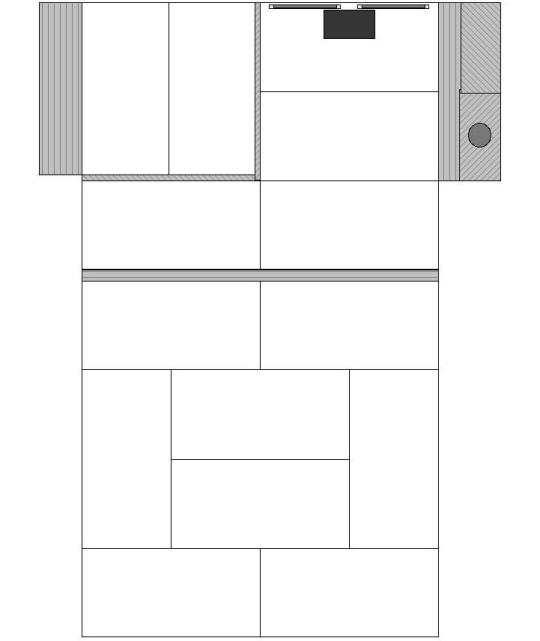
The details of Rikyū's shoin during this period are unclear. All that seems to be known with any certainty is that it had a 6-mat jō-dan [上段]. The above is a reconstruction based on the shoin in the Hisada family's residence* (however, the Hisada shoin had a 4-mat jōdan, rather than one of six mats). At any rate, this will give the reader at least a general understanding of the nature of the room in question. (Note that the 6-mat area at the top of the sketch is the jō-dan, in which a 2-mat area, in the upper left-hand corner, was raised still higher as the seat for the nobleman: the dashi-fu-zukue is appended to that part of the room, and it was there that the hand-scroll of Chinese poems was displayed -- together with Sugō‘s writing implements.)
Oide-nasare [御出被成] is a polite form meaning that Hideyoshi (and the others) moved on to the shoin.
Uma-no-toki [午時] means “at the hour of the Horse,” in other words, in the noon hour. Given the amount of food that was served, there likely was a certain delay, during which the guests inspected the objects that Rikyū had placed on display in the toko, and on tsuke-shoin and chigai-dana.
Oshō ha o-kaeru [和尚ハ御歸]: as mentioned in the previous post, Kokei Sōchin probably excused himself after the inspection because he did not care to participate in the banquet that would follow (which would naturally include fish and fowl, and drinking as well). This early departure would have been accepted by Hideyoshi without any ill feeling.
With respect to the kane-wari of this arrangement, the two kakemono and kōro count for three units, and so are han [半]. The writing implements count as a single unit (since they are grouped together, as shown in the sketch), while the hand-scroll of Chinese poetry is separate†, giving the dashi-fu-zukue a value of two, which is chō [調]. And the jikiro and bon-san arranged on and below the chigai-dana count for two units, and so the tana is also chō [調]. Han + chō + chō is han, as is suitable for the latter part of a chakai held during the daytime.
__________
*The Hisada family descended from one of Rikyū’s daughters, and seems to have actively tried to preserve Rikyū‘s legacy in details such as this.
†Tanaka Senshō said that he believed that the hand-scroll of poems was displayed on the chigai-dana, rather than the dashi-fu-zukue. While this disagrees with the way Rikyū has formatted the entry, it has no bearing on the total count, so far as kane-wari is concerned.
²Shiru tsuru [汁 鶴].
The first bowl of soup (probably a clear soup) contained crane.
Crane (and other large birds, such as swan and wild goose) were occasionally taken by Hideyoshi's hawkers (hawking was enjoyed by Hideyoshi and his court), and then prepared and served at court banquets -- as well as during chakai held within the palace complex when the fowl were available, as a sort of special treat.
Soup was made by boiling the bones, while the meat was usually mashed and formed into dango [團子] (meatballs), which were cooked in the broth along with pieces of daikon, mushrooms, and other seasonal vegetables.
³Namasu [鱠].
Namasu is a sort of salad, made from julienned daikon and carrot, served raw, dressed with a mixture of rice vinegar, soy sauce, and mirin.
⁴Ni-mono hara-hara gobō imo [煮物 ハラ〰 コホウ イモ].
Ni-mono [煮物] are food cooked (and usually served) in a broth. The difference between “shiru” (soup) and “ni-mono” seems to be that a soup course contains more liquid, while the ni-mono is primarily solid food*.
Hara-hara [はらはら]† is dried daikon strips‡; gobō [牛蒡] is burdock root; and, imo [芋] -- which is usually translated “potato” -- refers to the corm of the taro. These three vegetables were cut into bite-sized pieces and boiled in dashi**.
__________
*It is possible to serve the ni-mono in a bowl or dish without any soup at all, though in chanoyu some soup is usually included.
†Hara-hara [はらはら] means something like flutter down (like snowflakes). The image refers to the dried strips of daikon, which flutter (so they say) when the mound is fluffed (in the latter stages of drying) -- in contrast to the way the freshly chopped daikon would behave.
‡The daikon is cut into strips and sun-dried in a shallow basket for a week or so. This process sweetens it, and deepens its natural flavor. Modern-day kiri-boshi daikon [切干大根] is similar, though it is shreded more finely than hara-hara.
The hara-hara needs to be rehydrated (by soaking in water) before it can be used.
**Japanese soup-stock made by boiling kombu [昆布] (kelp) and katsuo-bushi [鰹節] in water.
For ichi-ban-dashi [一番出し] (used for miso-shiru and for cooking foods with a strong flavor), the kombu is boiled first (starting from cold water, after reaching a boil it is kept simmering for about 5 minutes, then the kombu is removed and a cup of cold water added to lower the temperature of the broth), then the katsuo-bushi are boiled (after returning to a boil, the katsuo-bushi are boiled for a further 5 minutes or so). The pot is removed from the fire and the katsuo-bushi allowed to settle, after which the clear broth is decanted.
Ni-ban-dashi [二番出し], which is usually what is used for ni-mono, reuses the above kombu and katsuo-bushi -- added to water, the mixture is brought to a boil, and then simmered for about 5 minutes or so (some people prefer to remove the kombu as soon as the liquid begins to boil, while others leave it in the pot for the entire session).
⁵Ni-no-shiru tara [二ノ汁 鱈].
This would be what is usually called tara sumashi [鱈清汁] -- a clear soup containing pieces of codfish (tara [鱈]), daikon*, e-no-ki mushrooms, leeks, and a small piece of yuzu-skin added to each bowl just before the soup was served.
__________
*Perhaps a little crushed garlic was also added to the soup, since Rikyū was from Sakai.
⁶Kawarake ko-tori [カハラケ 小鳥].
Ko-tori [小鳥] -- literally “small birds” -- is a generic term for the various sparrows and finches that were taken by the hawkers. These were cleaned (the heads, lower legs, feathers, and internal organs were removed) and then minced very fine, and mixed with miso. Then the mixture was baked on top of an unglazed plate set over a charcoal fire until the flesh was cooked.
This kind of miso-based food was always served with sake.
⁷Ae-mono udo [アヘモノ ウト].
Udo [独活] is a Japanese vegetable with long, asparagus-like stalks, that have a delicate, fennel-like flavor. When served as an ae-mono [和え物], the immature stalks are cut into julienne strips and then dressed with a mixture of rice vinegar and white miso (2 parts to 1), with soy sauce and sesame oil added to taste.
⁸Sashimi koi ・ mana-gatsuo [サシミ 鯉 ・ マナカツホ].
Koi sashimi [鯉刺身] refers to what is usually called koi-arai [鯉洗い]: the cleaned fillets of carp are placed into a hot water bath before being chilled in cold water.

Mana-gatsuo [真名鰹] (above) is a distant relative of the katsuo [鰹] (“slapjack tuna”). It has white flesh (whereas katsuo is pink to red in color) that is very oily. Accordingly, while delicious, people should not eat much of it, or it will cause digestive problems.
These would likely have been served with iri-zake [煎り酒]* as a dipping sauce -- though it is also possible that a shallow dish of precious soy sauce was offered to this important guest.
__________
*Iri-zake [煎り酒] is a sort of dipping sauce prepared from "old" sake (sake that has lost a lot of its alcohol through evaporation). First, a piece of dashi-kombu is soaked into the room-temperature sake for several hours (to deepen the taste), then removed. Then several ume-boshi are placed into the sake, and the sake is brought to a boil. After about 5 minutes, a large handful of katsuo-bushi is thrown in to the sake, and it is allowed to continue simmering until the volume is reduced by half. Then (as when making dashi) the pot is removed from the heat and allowed to cool for five minutes while the katsu-bushi settle. Then the clear liquid is decanted off (or filtered through a piece of sarashi).
This is the iri-zake, and it can be used as a dipping sauce once it is fully cooled.
⁹Kō-no-mono [香物].
Kō-no-mono [香の物] are vegetables pickled for a time* in a brine solution -- this is what is usually referred to as shin-tsuke [新漬け] today. The pickled vegetables (sliced cucumbers, hakusai, carrots, and so on) were usually served with crushed sanshō [山椒] (Japanese pepper) as a seasoning.
__________
*Ranging anywhere from overnight to several days, depending on the desired result.
¹⁰O-sakana tairagi ・ uzura [御肴 タイラキ ・ ウツラ].
O-sakana [御肴] refers to the course usually referred to as shii-zakana [強肴] today. Sakana [肴] means cooked or prepared food; while shii-zakana refers specifically to such food served as an accompaniment to drinking. Irrespective of the name, this course would have been accompanied by several rounds of sake.
The tairagi [タイラギ = 玉珧] (Atrina pectinata) is commonly known as the Japanese scallop or Comb pen-shell. It is the kai-bashira [貝柱] (the muscle that opens and closes the shells) of this mollusk that is eaten. This kind of scallop can be prepared in numerous ways -- including as sashimi, grilled over charcoal, broiled on the half-shell, cooked in broth, and even as tairagi-dengaku [たいらぎ田樂]*. Rikyū does not indicate how it was served.
Uzura [鶉] is the quail†. There are two ways it could be prepared. First is by mashing the flesh and bones into a paste, forming the paste into meatballs (dango [團子]), and boiling these in broth. Three dango are typically skewered on a bamboo brochette, and served in that way (either with a dipping sauce, or with some sort of sauce poured over).
The other way that these, and other fowl, were sometimes prepared for Rikyū's guests was as what he called senba-iri [船場煎り]: the cleaned quail were roasted over a wooden fire while being basted with a mixture of soy sauce (or possibly iri-zake [煎り酒]‡), sake, mirin, sesame oil, and perhaps crushed garlic (since this sort of food was endemic to the wharfs of Sakai).
__________
*Dengaku [田樂] is a type of grilled food, originally eaten by the peasants though taken up by the upper classes during the sixteenth century. The food (halved egg plant, momen-tōfu, shiitake mushrooms, or -- in this case -- scallops) is skewered and grilled over charcoal, and dengaku sauce is brushed over the upper side. After the sauce is dried, the food is turned over to caramelize the sauce.
The sauce is made by mixing white-miso (though red miso or other varieties can be used, depending on the preferred taste) with mirin, and sake (in the present white sugar is also added to make the taste sweeter -- though probably not in Rikyū's day): roughly, one measure each of sake and mirin (and sugar) are combined with two measures of miso.
†Tanaka Senshō comments that some people conflate these two things, resulting in tairagi-uzura, which they say means the quail were split in half and (presumably) grilled in that way.
‡See the sub-note ("*") under footnote 8. Iri-zake was often used the way soy sauce -- which was both rare and very costly in Rikyū's period -- is used today, both for cooking and as a dipping sauce.
¹¹Hasu [ハス].
By hasu [蓮] (lotus), Rikyū seems to be referring to ren-kon [蓮根], lotus root.
Usually lotus root is braised by sauteing ("stir-frying") the thinly sliced root (actually, it is a rhizome) in sesame oil, and then simmering in sake (until the liquid is gone), and then mirin (again, until the liquid is gone). In the present day this is usually followed by adding sake and continuing to simmer briefly, though this last step may have been missing in Rikyū's day (or the soy sauce was replaced by iri-zake).
¹²Sui-mono hashira ・ ko-kabu [吸物 ハシラ 小カフ].
Suimono [吸物] is food cooked (and served) in clear broth.
Hashira [ハシラ = 柱] seems to mean kai-bashira [貝柱] -- though most likely from a different variety of scallop than what he served above. Probably these were quite small.
Ko-kabu [小蕪] means small turnips -- probably from the kitchen garden, since kabura was one of the plants grown for winter greens.
¹³Kashi kan ・ senbei ・ zakuro ・ ko-neri ・ nashi [菓子 カン ・ センヘイ ・ サクロ ・ 小ネリ ・ ナシ].
Kan [柑] refers to the citrus fruit usually called mikan [蜜柑] -- tangerine -- today*.
Senbei [煎餅] are rice-crackers. They would have been procured from a specialty shop.
Zakuro [柘榴] is the pomegranate.
Koneri [木練り] are naturally formed hoshi-gaki [干し柿] (dried persimmons), and so of very small size†.
Nashi [梨] is the Oriental pear‡.
__________
*Mikan [蜜柑] means honey-sweet (mi [蜜]) tangerine (kan [柑]), and was probably originally a marketing term.
†Usually, natural koneri -- the name means to soften on the tree -- also have many seeds: the small size and presence of many seeds both facilitate the natural drying process (since larger fruit would simply rot before drying: artificially drying persimmons requires the removal of the skin for this reason).
‡The skin cannot be eaten, so the pear must be pealed and cut into bite-sized pieces. Oriental pears are more juicy than the Western varieties, so they are generally eaten with a yōji [楊枝] (such as a a small kuromoji [黒文字]), rather than with the fingers.
¹⁴Toko [床].
This was the toko in Rikyū's shoin, which seems to have been at a level below the jōdan [上段] -- the elevated seat for a noble guest -- as shown in the sketch.
¹⁵Ni-fuku ittsui Ba En san-sui [二幅一對 馬遠山水].
Ni-fuku ittsui [二幅一對] means a diptych, a pair of pictorial scrolls intended to be hung in the toko at the same time*.
“Ba En” is the Japanese pronunciation of Mǎ Yuǎn [馬遠; c. 1160 or 1165 ~ 1225]. Mǎ Yuǎn was an important painter, from a family of professional painters, of the Southern Song dynasty. Mǎ Yuǎn's works are mentioned six times in the Kun-dai Kan Sa-u Chō-ki [君臺觀左右帳記], by Nōami [能阿彌], and four times in Sōami's [相阿彌; ~ 1525] O-kazari Sho [御飾書].
Nōami notes that, when hung as a diptych, one scroll should be a landscape, while the other should have the figure of people. Meanwhile, Sōami indicates that the diptych of small scrolls consisted of one painting by Mǎ Yuǎn, paired with one by (Mǎ Yuǎn's contemporary) Xià Guī [夏圭 or 夏珪; dates unknown, but active between 1195–1224].
In the Kun-dai Kan Sa-u Chō-ki, Nōami simply segregates Mǎ Yuǎn's (and other artists') works by genre (landscape, birds-and-flowers, paintings of figures, and so forth), without giving them titles by which the individual paintings might be identified. And while Sōami's original manuscript of the O-kazari Sho originally included small sketches of all of the works cited, none of the subsequent copies (which are all that survive) have any. Consequently, it is impossible to determine which of Mǎ Yuǎn's works were displayed by Rikyū on this occasion -- or whether or not those paintings are still extant today.
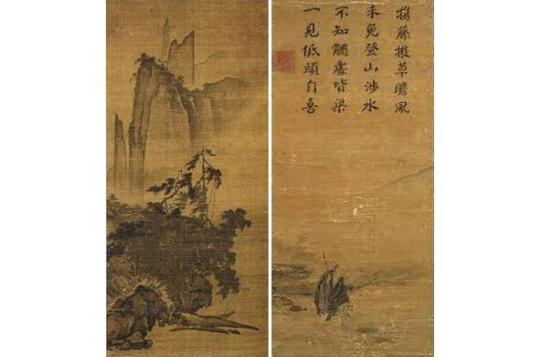
Above are two of Mǎ Yuǎn's surviving paintings which I selected as representative based on Noami's specifications regarding the two scrolls included in a diptych†.
__________
*The pair of scrolls were usually prepared with identical mountings, indicating they were part of a diptych.
†A glimpse of the mountings are usually not included in photographs of these works (and most were remounted during the Edo period anyway, since the preferred proportions came to be based on Kobori Masakazu's [小���政一; 1579 ~ 1647 -- he is better known today as Kobori Enshū, 小堀遠州] creations, rendering the earlier continental model employed by Nōami and his fellow dōbō [同朋] uninteresting), thus even this potential clue to which of the paintings were used as diptychs is lacking.
Most of the diptychs and triptychs that were decided upon by the dōbō-shū [同朋衆] were broken up during the early sixteenth century, and those that continued to be used together were almost all split divided into different collections in the Edo period. Thus there is no clear historical evidence to go by, either.
¹⁶Sai-kōro guri-guri ko-dai ni [豺香爐 グリ〰香臺ニ].
The kanji sai [豺] means a jackel*. It seems that Rikyū is referring to a piece that would usually be classified as a variety of shishi kōro [獅子香爐]†.
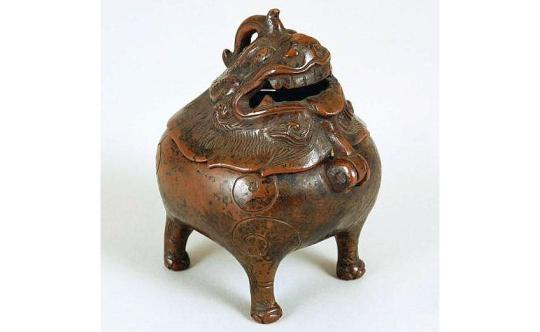
The above piece, made of purple bronze, was one of Jōō's personal treasures, may be the kōro that Rikyū displayed on this occasion‡.
Since this, and several other utensils that Rikyū used on this occasion eventually ended up in Hideyoshi's collection (without the records indicating that they had been owned by Rikyū previously), some scholars have suggested that Rikyū did not actually own them, but that he had taken them on consignment from other Sakai chajin, with the intention being that, should Hideyoshi like them, they would be sold to him for a good price (which Rikyū naturally would negotiate -- while accepting a generous fee for facilitating the sale from the original owner**).
Unlike Rikyū’s kōgō, the guri-guri kō-dai was probably black††.
__________
*In Japan, where such exotic creatures had never been seen, the sai was reimagined as a yama-inu (which name is more commonly written yama-inu [山犬], meaning a kind of feral dog). The Japanese wolf (ōkami [狼], Canis lupus hodophilax), with which the sai is sometimes equated, differs in several ways from the yama-inu. In fact, recent genetic evidence suggests that both of these creatures were ancient wolf-dog hybrids (the Japanese wolf has been considered extinct since the early 20th century).
That said, it is not clear whether Rikyū actually considered this kōro to resemble a wolf, or whether he simply wrote the wrong kanji.
†With which speculation Tanaka Senshō concurs.
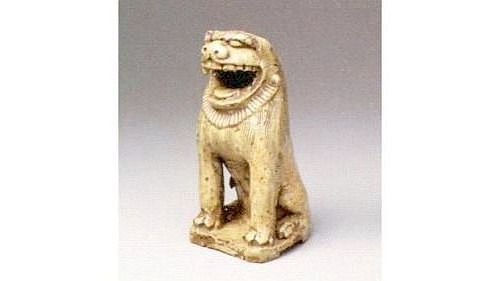
‡The other “shishi-kōro” [獅子香爐] commonly associated with Rikyū was one made for him of pale-yellow Seto ware by Furuta Sōshitsu, shown above. However, this would have been too many things made by Oribe, so the purple bronze kōro seems more likely.
**As a number of these utensils actually had been among Jōō's personal treasures, it is possible that they had been passed to Rikyū by Imai Sōkyū, who was managing Jōō's estate on behalf of Jōō's son Sōga [宗瓦; 1550 ~ 1614].
Rikyū accused Sōkyū of selling these things and then keeping the profits for himself (which Sōkyū said was to reimburse himself for the expenses of Sōga's upkeep); and this may have been how Sōkyū's name came to be associated with this chakai (the inclusion of this gathering in the Imai Sōkyū Chanoyu Nikki Nuki-gaki [今井宗久茶湯日拔記], mentioned above under footnote 6 -- which collection seems to be at least partly spurious -- may have been calculated to support these accusations; or, possibly, to validate the traditional denrai [傳來] of certain pieces in the Tokugawa family collection -- pieces which do not appear to have had any actual connection with Rikyū, beyond the assertions made in this document).
††Guri-guri pieces were painted with alternating layers of red and black lacquer. While Rikyū's guri-guri kōgō had red as the outermost layer, most guri-guri pieces (especially furniture and trays) seem to be finished with black lacquer (probably so scratches would be less visible). Guri-guri-nuri is not shiny like shin-nuri.
¹⁷Shoin-doko [書院床].
Shoin-doko [書院床] seems to be Rikyū's name for the dashi-fu-zukue [出し文机], the built-in writing desk that was found in the shoin.
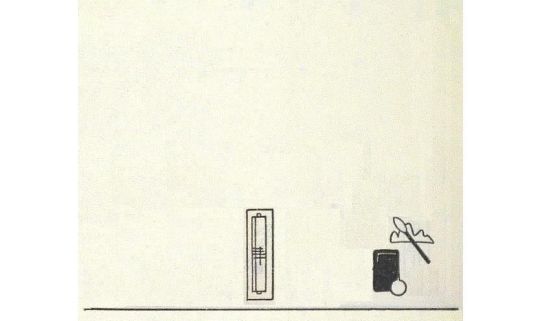
The way to arrange the writing implements on the dashi-fu-zukue is based on Nōami's recommendations in the Kun-dai Kan Sa-u Chō-ki.
__________
*This built-in desk is usually called a tsuke-shoin [付書院] today.
¹⁸Sugō suzuri, kame mizu-ire, fude-kake, hitsu sumi, Sugō jiku-mono [子昂 硯、龜水入、筆架、筆 墨、子昂 軸物].
Sugō [子昂] refers to Chén Zǐáng [陳子昂; 661 or 656 ~ 702], an important poet of the Tang period. In fact, according to scholars, Chén Zǐáng was responsible for bringing into being the style of poetry that is considered to be “characteristically Tang.” By many he is considered to be the first poet of the Tang period.
The objects arranged on the dashi-fu-zukue seem to have been all associated with Chén Zǐáng:
◦ Sugō suzuri [子昂 硯] -- this ink stone was supposedly the one owned by Chén Zǐáng;
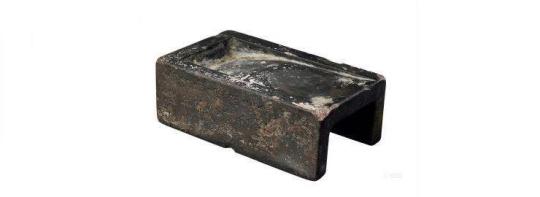
◦ kame mizu-ire [龜水入] -- this was his water-dropper;

◦ fude-kake [筆架], this was a small stand (sometimes carved from precious wood, sometimes made of pottery, and sometimes of jade or other stone) against which brushes were rested, so the brush would not roll around, or the wet head stain the desk (or paper on which the person was writing) -- however, the fude-kake in question has not been identified;
◦ fude ・ moku [筆 ・ 墨] means a brush and an ink stick (while probably both imported from the continent, the specific brush and stick of ink, or who the previous owner might have been, cannot be known from the little that is written here);
◦ Sugo jiku-mono [子昂 軸物] -- this was probably a horizontal scroll, an anthology of Chén Zǐáng's poems, though whether it was an actual Tang period manuscript, or (more likely) a later continental copy, is unknown: the scroll has not been identified.

Above is a late Song or early Yuan period hand-written copy of one of Chén Zǐáng's poetry collections. The jiku-mono displayed by Rikyū on this occasion may have appeared similar to this.
Perhaps some of these things (as well as other objects displayed in the shoin) had originally belonged to Jōō (certainly, as a trained poet, Jōō would have enjoyed owning just such relics of a very significant poet from the past), and were on loan to Rikyū (from Imai Sōkyū*, into whose keeping they had been given when Jōō died† -- hence his name being ambiguously associated with this chakai) so that Hideyoshi might view them (and possibly purchase them). While some of these things were used by Rikyū at future chakai, other things are associated with him this one time only, after which the denrai [傳來] suggest they entered Hideyoshi's collection (often without mentioning Rikyū as a previous owner at all), and passed from him (surely unintentionally, at least on his part) to the Tokugawa family, where they still remain.
As mentioned above, Tanaka Senshō argues against the jiku-mono being placed on the tsuke-shoin (even though that is how the kaiki is formatted). He prefers to think that the scroll was displayed on one shelf of the chigai-dana (with the jikirō placed on the other). Nevertheless, at a chakai included in the Rikyū Hyakkai Ki, an open scroll is definitely displayed on the dashi-fu-zukue, and the way Rikyū wrote the present account suggests that this was his preferred way to do things‡.
__________
*Imai Sōkyū was married to Jōō's sister, and hence his brother-in-law.
†Jōō's son Sōga was a child of 5 when Jōō died, and Sōkyū was designated both foster parent and executor of Jōō's estate.
It is said that the bad blood between Rikyū and Sōkyū was occasioned by Sōkyū selling some of the meibutsu utensils that had belonged to Jōō, and then keeping the profits for himself. Sōkyū claimed this was to reimburse his purse for expenses related to Sōga's upkeep; but Rikyū was disinclined to accept this explanation. Perhaps this chakai was the occasion on which this sale was initiated -- and, if so, Rikyū would therefore have been intimately aware of the monetary details, since he would have negotiated the price with Hideyoshi on (he would have assumed) Sōga's behalf.
‡The scroll was supposed to be inspected by the guests. Displaying it on the chigai-dana may have encouraged them to wait until Rikyū entered, so he could retrieve it for them. Placing the scroll on the writing desk, however, would invite them to inspect it at their leisure without waiting for the host to help them -- and since part of the reason for the delay was so that the meal could be prepared, this seems like it might have been the best way to do things.
¹⁹Chigae-dana [チカヘ棚].
Rikyū's semi-phonetic rendering of the word chigai-dana [違い棚] -- the staggered shelves usually found adjacent to the dashi-fu-zukue.
The jikirō [食籠], containing kashi, was probably placed on the lower of the two shelves (while the upper shelf remained empty), with the bonsan displayed on the floor beneath the pair of shelves, as was customary.
²⁰Jikirō [食籠].
This was a container -- originally a lacquered basket (as the name implies) -- for kashi that was displayed on the chigai-dana -- together with a bon-san [盆山].

Rikyū's jikirō has not been identified, though the one shown above (which was made during the Ming dynasty) seems to agree with his taste.
²¹Bon-san Kiji [盆山 紀路].
Kiji [紀路] is the name of a bon-san*. It has not been identified, and may have been lost. Perhaps it served as the model for Rikyū's sketch, found in the Nambō-ate no densho [南坊宛の傳書] (though the sketch is just as likely to be fanciful).
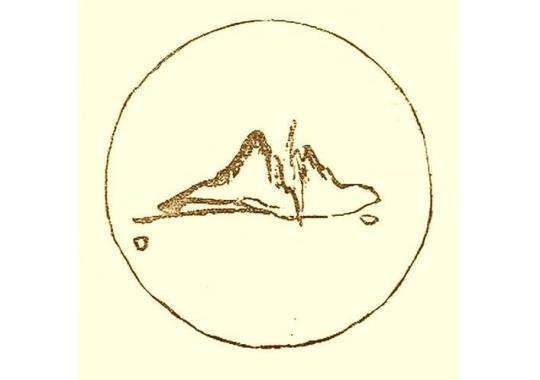
According to the Yamanoue Sōji Ki [山上宗二記], only two of the viewing stones belonging to Ashikaga Yoshimasa were worthy of note (and so suitable for display during chanoyu gatherings)†:
- The first of these was named Zan-setsu [殘雪].
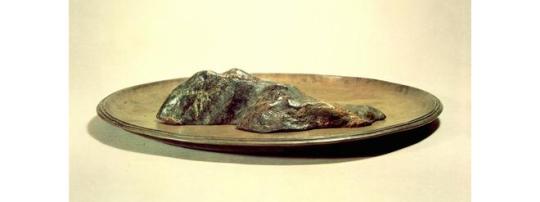
- The second was called Sue no matsu-yama [末ノ松山], and that stone is shown below.

According to Sōji, these stones were sometimes arranged on a shallow Korean platter (kōrai-bachi [高麗鉢])‡, and sometimes in a lacquered naka maru-bon [中丸盆]**, both of which may be seen in the photos, above.
__________
*Bon-san [盆山] literally means a mountain in a tray (or a tray-sized mountain). The more modern words bon-seki [盆石] (stone arranged on a tray) and sui-seki [水石] (an abbreviation of san-sui-seki [山水石], which means a landscape stone) refer to the same things. They are often referred to as “viewing stones” in English.
In Yoshimasa's period, these kinds of stones were used in a type of meditation practice, with ones vision concentrated on the stone until one entered into a state of peace (after mentally running though the various thoughts that the sight of the stone inspired). According to a poem by Yoshimasa, when arranged on a tray, two mounds, representing sand-dunes, should be raised up in front of the stone, while the sand behind the stone should be raked to resemble waves (the nature of which was changed depending on the natural conditions of the ocean during that season).
†Apparently Yoshimasa had assembled a sizeable collection of these stones -- which usually resemble distant mountains, or suggest other such scenes from nature -- over the course of his lifetime. But only these two stones had been celebrated in poems, and it was perhaps for that reason that they were judged suitable for display during chakai (while the others were rejected by Sōji).
The same sort of (what we might consider) nitpicking is found with respect to which of the Ogura shikishi were originally considered “suitable” for display in the tearoom: while they were all written by Fujiwara no Sadaie, and all represent poems carefully selected by him and his committee of eminent courtiers (and written on paper selected by him to complement the verse that he would write on it), Jōō is said to have declared that only those poems written on paper that had a background painting on them (the paintings were done by professional artists) could be hung in the toko, while those written on plain colored paper (or Chinese paper with a block-printed decoration) were “wholly unsuitable” for use in chanoyu.
‡This shallow platter (it is described as being a Korean bowl, korai-hachi [高麗鉢] in the Yamanoue Sōji Ki) was made of Korean bronze or sawari [四分一] (it is variously referred to as a kane-no-hachi [金ノハチ], and sometimes as a Namban karakane [南蠻カラカネ], in the various kaiki from the sixteenth century in which it is mentioned: sawari is a pale gold with black mottling when it has not oxidized, and this aggrees with the platter seen in the photo).
**This tray was 1-shaku 2-sun 3-bu in diameter, with straight sides (that had a raised band on the outside, as can be seen in the photo). Yoshimasa seems to have used this tray because the original (which was destroyed when Yoshimasa's storehouse was burned down during the Ōnin Wars) had a brass plate inlaid into the face of the tray (the tray seems to have been used in China for carrying hot containers of food from the kitchen to the residental apartments). The brass plate would protect the face of the tray from being scratched by the sand or the bottom of the stone.
²²Gyo-i ni te daisu kazari, taikai ni te o-cha tate [御意ニテ臺子カサリ、大海ニテ御茶立].
Gyo-i [御意] means according to the pleasure (of the noble guest); according to the desire (of the noble guest). In other words, Hideyoshi requested Rikyū to bring his daisu out of storage and display it in the shoin.

Above is Rikyū's daisu and kaigu from this period in his life. This daisu was made around 1586, and so some months before this chakai (during which it may have been used for the first time). After Hideyoshi was initiated into the gokushin futatsu-gumi temae, he forbade Rikyū to teach that temae to anyone else without his express permission. At that time, Rikyū modified the proportions of the daisu (by making the legs half their previous thickness -- this was enough to move the furo and mizusashi far enough apart so that the previous effect was lost), and then had this daisu made to reflect the changes. This was the daisu that Rikyū used from that time until his death (and it -- along with Sōtan's “wabi daisu” that is cobbled together from parts of several old daisu, so the ten- and ji-ita are different sizes -- is the daisu that is known and used today).
Rikyū's Seto taikai-chaire [瀬戸大海茶入] is shown below.
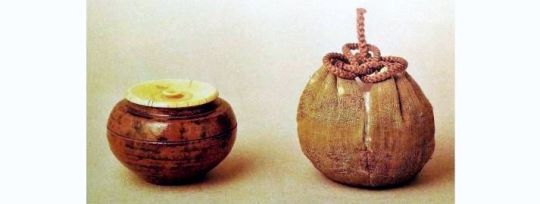
The expression o-cha tate [御茶立] is very formal, and means that tea was prepared (using the daisu) by Hideyoshi. Under the circumstances, it is likely that Hideyoshi served usucha to Tsuda Sōkyū and Rikyū -- and perhaps drank a bowl himself.
The chawan is not mentioned, but perhaps it was the same one that Rikyū used earlier, the Shima-suji-kuro [嶋筋黒] bowl made by Furuta Sōshitsu.
Hideyoshi probably performed his temae using the furo.
1 note
·
View note
Photo

Uluslararası Kedi Günü kutlu olsun!! 🐈🐱 Happy International Cat Day!! 🐈🐱 1- Robert Martineau - Girl with a Cat/ 2- Jean-Jacques Bachelier - White Ancora Cat chasing a butterfly / 3- Antonio Carneiro - Girl with Cat / 4- Yasushi Tanaka - Cat and Flowers / 5- To Yokoku - Cat with Hydrangea / 6- Child in Yellow Dress with Grey Cat / 7- Oide Toko - Cat watching a Spider / 8- Abraham Bloemaert - Youths Playing with the Cat / 9- He Yu - Cats & Peonies / 10- Julie Held - Girl with a Cat #internationalcatday #cat #kedi #uluslararasıkedilergünü #uluslararasıkedigünü #art #sanat #benibunaannemzorladi https://www.instagram.com/p/B06baE6Aq4A/?igshid=1wrtlwhv5dya6
#internationalcatday#cat#kedi#uluslararasıkedilergünü#uluslararasıkedigünü#art#sanat#benibunaannemzorladi
0 notes
Audio
Wanna Wanna HAATO ni umareta ganbou
BARABARA NOOTO no sumi de bousou
achikochi tobichiranai you ni atsumete
yume wa egaitara ato wa utau dake
seifuku nuidara chotto SUGOi yo?
kitete mo mochiron SUGOi kedo
sakikurutte tawawa minoru kajitsu wa MEJAA?
MAINAA??
gosenfu no ue ja donna KOTO mo dekiru
mabataki kinshi zenbu zenbu, mitete
wana wana HAMAtta kara ni wa tannou
(Join us Join us)
JARAJARA deguchi wo motome meisou
(Listen Listen)
achikochi tobiarukanakute mo jitsu wa
(Our dreams come true)
yume ga kanau tottoki no sube ga aru
(Secret Secret)
jugyouchuu no ichijikan ga nande houkago ja isshun
sakihokotte urara yamatonadeshiko wa eien
gosenfu no ue ja donna TOKO mo ikeru
HETAru hima nashi tsuite tsuite, oide
Happy-sugi!? Sorry!! utaidashitara saigo
GOKIGEN na FUREEZU museigen ni REFUREIN
Happy-sugi!? Sorry!! hajimete demo Ride On
SUTAIRU wa FURII BIITO ga aeba soku-FURENZU
gosenfu no ue ja donna KOTO mo dekiru
heibon na kyou mo nante nante, EKUSAITINGU
Happy-sugi!? Sorry!! FUKIGEN demo Ride On
SUMAIRU wo PURIIZU YUNIZON de RIKABARII
Very Very Sorry!! utaidashitara saigo
GOKIGEN na FUREEZU museigen ni REFUREIN
59 notes
·
View notes
Text
童怪奇譚

Album: Doukaikitan
Artist: Absolute Castaway
Kageboushi
hitotsu potsuri kageboushi
hana no kasa shoujo ga hitori
shanshan sharara suzu yurasu
takeumagokko wa sayounara
umi no mukou no oningyou daite
kakasa ma nemuru tsuchi no moto
isshobun no omairi ni
hitotsu yurari kageboushi
aoi hitomi no ijin ga hitori
shanshan sharara hana wo tsumu
hito yo no yume wa sayounara
hanareru naraba kono ude daite
taoreba towa to fue wo fuku
yukusaki shiru wa kaze nomizo
hitotsu futatsu kageboushi
yami wa mayakashi to usobuku you ni
hosomichi terasu otsuki-san
te te wo tsunaide kage hitotsu
yoseru namioto kogareta wo koe
shanshan sharara fune wa tatsu
Garasu no Hitsugi
hana no kaori amai wana no naka
anata no tame dake ni yooi sareta butai
utsukushii yo totemo kirei da to
kono sugata wo mederu kooru you na shisen
sono hane ga kusumanu you ni to
ataerareta nozomanu yurikago
utsurona hitomi ga kutsuu ni yugamu
kurai rougoku torawareta chou
semete yume no naka de hirahira to
saa buyoure adeyaka ni adeyaka ni
mushibamu you na fukai yami no naka
watashi no tame dake ni yooi sareta hitsugi
sono nakigara wo moteasobu yubi
dokusen wo yorokobu michitarita hohoemi
sono hane ga kuzurenu you ni to
towa wo utau kooreru hakoniwa
azayakana hane ga hitsugi ni shizumu
kushizashi no hane ugokanu karada
semete omoi dake wa hirahira to
saa buyoure adeyaka ni adeyaka ni
koko kara dashite koko kara dashite
watashi jaa tobira wo hirakenai no
tsumetai kago no tobira wo akete
atatakana hikari ni hirahira to
mou ichido dake adeyaka ni adeyaka ni
hirahira to hirahira to
togireru ishiki yuruyaka ni yuruyaka ni
hirahira to hirahira to
ochite iku dake yuruyaka ni yuruyaka ni
hirahira to
Kamigakushi
asobi ni iku nara kono ko mo tsurete kya
chinomigo seotte te tera tsunaide
hi ga kuretara modotte kon sha
yaman naka he ittara akan
hi ga kuremai modotte kiiya
yaman kami-sama sasoware chimau
anta gata doko sa ano yama mukou ja
takigi hiroute o uta wo utoute
asobi nagara hataraken domo
yaman naka wa totsuku ni chikaute
hi ga kurendo modotte kiiya
kuchi urusau iwareteyou yo
sondaba iresho itte miya sensho
mejirushi oite te tera tsunaide
hi ga kuretado modorana akan
kikanto oku he ittara akan
sato he modoryaba ano ko wa doshita
yaman kami-sama orareru toko ja
Albino
tooku hikaru gin'iro no hosoi tsuki
kiri sakareta asai kizuguchi no you ni
onaji iro no usagi wo sasogu
kocchi he oide
koko wa doko watashi wa dare
dare tomo chigau kenami
shiroku haete ukabi agari
doko ni mo majirenai
usagi usagi nani mite haneru
koko de wa nai dokoka he
toogenkyou wo yumemite haneru
watashi wo tsuretette
awaku ukabu oborogena marui tsuki
kuchi wo aketa amai nigemichi no you ni
akai me wo shita usagi wo sasogu
kocchi he oide
anata wa dare doko he yuku no
dare tomo chigau kotoba
sotto yasashiku dakiageru
nanni mo wakaranai
usagi usagi nani mite haneru
yasashii ude ni dakare
atatakasa ni tomadoi omou
watashi demo ii no?
usagi usagi nani mite haneru
juugoya otsuki-sama mite haneru
usagi usagi nani mite haneru
ichido shitta nukumori wo
nakusanu you ni hisshide haneru
mujihina tsuki ni negau
watashi no iro watashi no katachi
sore ga ii to yasashiku warau
sono kotoba to manazashi dake de
watashi wa ikite yukeru
gin no kenami shinku no hitomi
watashi wo shimesu hokori
anata no aishita watashi
Temari Uta
te te te temari wo tsukimasho ka
te te te temari wo tsukimasho ka
hitotsu futatsu mittsute
te te te temari wo tsukimasho ka
ora no koe ga kikoeru kai
yottsu itsutsu muttsu
te te te temari to utaimasho
ora to issho ni utaimasho
nanatsu yattsu koko no tsu
te te te temari wa modorimasu
ora no o te te ni modorimasu
mittsu futatsu hitotsu
te te te temari wo tsukimasho ka
te te te temari wo tsukimasho ka...
Tooryanse
hitotsu tsunde wa haha no tame to
kayoi aruita kono hyaku no hibi
dokomademo tsudzuku aka torii
ranpu wo tayori ni arukimasu
ko~n ko~n
dareka ga hito wo uramu you ni
ichizuna omoi de susumimasu
yasashii kao shita kakasama ni
douka
mo ichido awasete kudasaimase
tooryanse tooryanse
kuchizusande
tooryanse tooryanse
tooryanse tooryansee
kono negai wo ten made
tooryanse
otenki ame ni michibikarete
tadoritsuita kitsune no odou
sukoshi yasumasete kudasai na
okitsune-sama wa waratta
kon kon kon
tooryanse tooryanse
kocchi ni oide
tooryanse tooryanse
tooryanse tooryansee
watashi wo tsurete doko he
tooryanse
mekakushi oni yo doko he yuku
tete wo hiku no wa dare kashira
koko wa doko watashi wa da~re?
tooryanse
kuchizusamu
tooryanse tooryansee
kitsune no omen ga waratteru
watashi wo tsurete doko he
tooryanse
3 notes
·
View notes
Photo

A Cat Teasing A Bullfrog, Oide Toko (1841 - 1905)
221 notes
·
View notes

